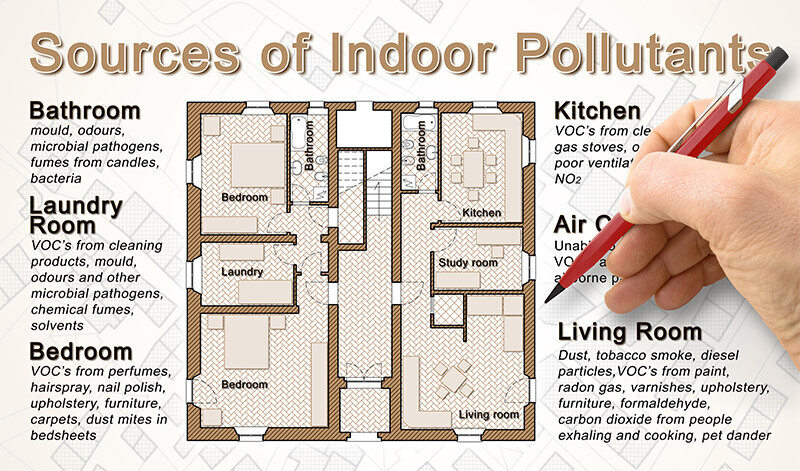A silent pollutant lurks in our homes and offices, a volatile substance potentially harmful to human health (and life). That pollutant is formaldehyde.
Officially listed by the IARC as a known carcinogenic to humans, formaldehyde is also present in high concentrations in furnishing items and many other everyday products, undermining the day to day healthiness of indoor environments.
But what exactly is formaldehyde? Why is it so dangerous? Is there a way to permanently eliminate formaldehyde from indoor areas? Let's find out together.
What is formaldehyde?
Formaldehyde, also known as methanal (chemical formula CH2O), is an organically derived compound that is industrially produced for a variety of uses, in sectors that range from medical-health to food, industry and furniture.
Its versatility is unrivalled. At room temperature, formaldehyde is colourless and gaseous, recognizable by its acrid odour. However, chemical transformation processes may cause it to take on a liquid form.
It also dissolves quickly in air and is soluble in water. This union with water gives rise to formalin, a special solution containing 35-40% formaldehyde that is widely used as a disinfectant, in cosmetic products and as a preservation agent.
Formalin is not the only formaldehyde ‘derivative’. The molecule is also an important reagent: not surprisingly, it is used to produce more complex compounds and materials.
These include urea-formaldehyde resin, a substance used extensively in medium density fibreboards (MDF), chipboard and faced-wood panels.And this, crucially, is where we learn where formaldehyde is found.
Formaldehyde: where it’s found
Thanks to its versatility and ease of use, formaldehyde is present in many everyday objects: even personal care and home cleaning products contain small percentages of it.
But where formaldehyde is found most is undoubtedly in the construction materials used for buildings and furniture.
Chipboard, MDF, lacquered and laminated furniture can contain high concentrations due to the adhesives and resins used to thicken the panels. This is why furniture and formaldehyde are often cited together as a source of indoor pollution.
Note that upholstery and floor coverings can also be a source as carpets and rugs can contain, albeit minimally, methanal-based compounds. Then there’s smoke: whether generated by a fireplace, a stove, cooking or cigarettes, combustion produces minimum amounts of formaldehyde that can easily settle in the environment, especially if ventilation is poor.This is not good news. As we shall see, formaldehyde is very harmful to health.

Formaldehyde toxicity: health risks
The presence of formaldehyde in furniture, upholstery and cleaning products can contribute considerably to making indoor areas unhealthy. It is scientifically proven that its excessive presence in indoor areas is harmful to health, even carcinogenic.
Over time, formaldehyde is released by the resins used in furniture and dissolves in the air.
Such emissions have a brief lifespan in outdoor environments as they are easily degraded by natural phenomena such as rain and sunlight. Indoors is a different matter: it is here that toxic formaldehyde takes on a much more worrying significance as it’s impossible to eliminate all emissions.
If we also take into account that release rates increase as temperature and humidity rise, the problem becomes more serious.
The greatest danger stems from prolonged exposure to formaldehyde, either by inhalation or contact. The WHO has even set a maximum concentration level of 0.1 mg/m3.
Once you understand what it is and where it’s found, the most important question still remains: how to eliminate formaldehyde?
Choose air sanitising devices
As seen, formaldehyde emissions are most likely to be concentrated in indoor environments. For this reason, the best formaldehyde elimination strategy, in addition to ventilating the premises, is to use UV LED air sanitising devices.
UV LEDs can, in fact, thanks to their short wavelength, eliminate many harmful particles from the air: not just contaminants such as formaldehyde, but also fumes, viruses, bacteria and other potentially harmful microorganisms.
C-led designs and manufactures PURE, a range of indoor air purifying and sanitising devices.
Thanks to UV-A LED technology with photocatalysis - completely safe as it uses no chemical compounds - PURE can be used where people or animals are present and is therefore ideal for decontaminating the indoor environments where you live, work, study, etc from formaldehyde and other harmful substances
Now that you know where formaldehyde is and how to eliminate it, all you need to do is take action by choosing the right ‘allies’ to lower the amounts of this dangerous volatile compound in the places where you live and work every day.
